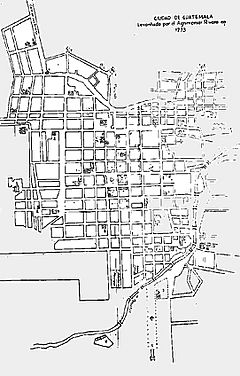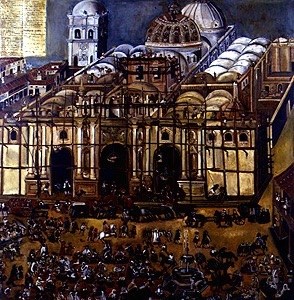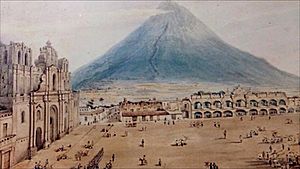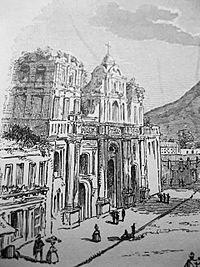Antigua Guatemala Cathedral facts for kids
Quick facts for kids Cathedral of SantiagoParish of San José |
|
|---|---|
|
Catedral Primada de Santiago;
Parroquia de San José (Spanish) |
|
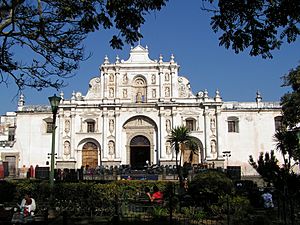
Cathedral of San José, 2007
|
|
| Religion | |
| Affiliation | Catholic Church |
| Province | Santiago de Guatemala |
| Rite | Roman Rite |
| Ecclesiastical or organizational status | cathedral |
| Leadership | Archbishop Cardinal Rodolfo Quezada Toruño |
| Year consecrated | 1541 |
| Status | World Heritage Site |
| Location | |
| Location | Antigua Guatemala, Sacatepéquez |
| Municipality | Antigua Guatemala |
| Territory | Archdiocese of Guatemala |
| Architecture | |
| Architectural type | church |
The Parish of San José (also known as the Cathedral of San José) is a famous church in Antigua Guatemala. It's part of the Archdiocese of Santiago de Guatemala. This church is built on a part of the original Primate Cathedral of Antigua Guatemala. The first cathedral was badly damaged by the 1773 Guatemala earthquakes.
Building the first cathedral started in 1545. Workers used stones and materials from an earlier settlement that had been destroyed. Earthquakes often stopped the building process over the years. In 1669, the first temple was taken down. A second church was opened in 1680, built by Juan Pascual and José de Porres. There's also a record that Spanish engineer Martín de Andújar Cantos helped with its rebuilding.
Contents
History of the Cathedral
Building the Cathedral
The Cathedral of Santiago was built three times. The last version was officially opened in November 1680. This work was led by master Joseph de Porres. After the 1717 Guatemala earthquake (also called the San Miguel earthquakes) in 1718, Diego de Porres fixed parts of the church. He repaired the curved ceilings, arches, dome, and the front of the building.
The main altar inside the cathedral stood under a large dome. It was held up by sixteen columns. These columns were covered with a special material called carey and decorated with fancy bronze designs. Above the columns, there were statues of the Virgin Mary and the twelve Apostles, all made from ivory.
In 1743, the Cathedral of Santiago de Guatemala became a Metropolitan Cathedral. This was a very important event, and big celebrations happened in February 1745. A special cloth called a pallium was brought from Europe for the occasion. When the bishop arrived, many important people came out to meet him.
The celebrations were grand, with bells ringing and fireworks. Public officials went to the beautifully decorated cathedral for a special mass. When the pallium was placed on Archbishop Pardo y Figueroa, there were more bells, firecrackers, and a gunpowder castle in the square. A fancy dinner followed for important guests.
The party continued all night with more fireworks. For the next eight days, different religious groups held their own celebrations. There were also local dances, horse races, and bullfights in the main square. One historian, Domingo Juarros, estimated that about fifty thousand pesos were spent on these events.
The Santa Marta earthquake of 1773 caused serious damage to the cathedral. Two of its chapels were fixed in the early 1800s. Underneath the church, there is a crypt and a network of tunnels. We don't know what these tunnels were used for.
The cathedral also held the remains of the conqueror Pedro de Alvarado. His daughter asked for them to be moved there in 1568. In the 1940s, his remains were moved again. They were stored in the Municipality of Antigua Guatemala after an earthquake in 1976. In December 2007, they were finally returned to the same spot in the Cathedral of Antigua Guatemala.
Moving to New Guatemala City
After the 1773 earthquakes, the cathedral was moved to Nueva Guatemala de la Asunción (Guatemala City). This happened on November 22, 1779. Another church, the Parish church of El Sagrario, also moved in May 1780. The altars, furniture, and instruments from the old cathedral were left behind. In 1783, they were moved and stored in the University of San Carlos building and in the sacristy of the Parish El Sagrario. The huge walls of the old cathedral remained standing, and the inside was used as a cemetery.
The Parish of San José Takes Over
In 1804, Archbishop Peñalver y Cárdenas decided to create the Parish of El Señor San José in Antigua Guatemala. This new parish combined three smaller parishes. The new parish received an important statue called the Lord of the Descent, which is still honored there today.
In 1806, Father Rafael José Luna, the priest of San José, thought about using the ruins of the old cathedral as the new parish church. In 1814, church leaders agreed. In 1819, they started to fix up the building. They tore down damaged parts, like the bell towers. The work stopped for a while but started again in 1832. When the repairs were finished, the Parish of San José moved from the old University of San Carlos building to the old cathedral. It has been there ever since.
The 1874 Earthquake
According to The New York Times newspaper, the earthquake in Guatemala on September 3, 1874, was one of the most damaging earthquakes that year. There were also reports of groups trying to rob people who had lost everything. Luckily, the police caught these groups, and they were quickly punished.
One person who felt the earthquake said it felt like the ground was moving up and down and side to side, like waves. It seemed to rise about a foot higher than normal. The earthquake caused about $300,000 in damage. Many towns were affected, including Antigua Guatemala, Dueñas, Parramos, Patzicía, Jocotenango, San Pedro Sacatepéquez, and Amatitlán.
The photographer Eadweard Muybridge visited Antigua Guatemala in 1875. He took pictures showing the city after this earthquake. If you compare his photos with older drawings, you can see that the Parish of San José lost its bell towers in this earthquake.
In 1897, a writer named Ariza Poitevín described the cathedral ruins. He said there were many ruined temples and buildings. Thick tree roots grew through cracks in the walls because the buildings were left alone. He mentioned that the cathedral could be visited, but it was difficult. The air was damp and smelled bad, and there were many night birds and bats, making the place look gloomy.
The 20th Century
In 1918, after earthquakes hit Guatemala City, Herbert J. Spinden visited the Cathedral of Antigua Guatemala. He was a reporter for the American science magazine National Geographic Magazine. Spinden described the cathedral's condition: "The front of the cathedral faces the city's main square and hides a large area of destroyed buildings. You can enter the ruined main area through a side door. You pass under the central dome, where the pillars are beautifully decorated with angels and maze-like designs. Or, you can go up to the roof and carefully walk on the plants that have grown on the beams connecting the egg-shaped domes."
Image gallery
See also
 In Spanish: Catedral de San José (Antigua Guatemala) para niños
In Spanish: Catedral de San José (Antigua Guatemala) para niños


